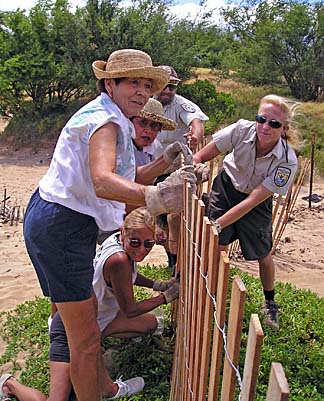
Signs point
to turtles
making comeback
KIHEI, Maui >> Federal and state experts are hopeful that endangered hawksbill turtles will build more nests in Hawaii this year, in light of early activity on Maui and Big Island beaches.
Compared with a high of about 60 nests sighted statewide in the late 1990s, hawksbill activity was relatively low last year -- no nests in Maui, two or three on Molokai, and 23 nests on the Big Island, federal experts said.
SAVE THE TURTLES
Those wishing to volunteer to help in hawksbill turtle projects may contact:>> Will Seitz or Eldridge Naboa on the Big Island, 985-6090
>> Glynnis Nakai on Maui, 875-1582
While the normal June-November nesting season has just started in Hawaii, eggs have been laid in three hawksbill nests in the southern coastal area of the Big Island, and there have been two unconfirmed reports of nesting in the Punaluu areas, according to federal officials.
A nest of eggs believed to be from a hawksbill has also been seen in Makena in south Maui.
"That's really good news," said George Balazs, a sea turtle biologist with the National Marine Fisheries Service.
Lawrence Katahira, a resource management specialist for Hawaii Volcanoes National Park, said the number of new female hawksbills have been increasing on the Big Island by at least one a year since 1999.
Katahira said the latest newcomer, with a smaller carapace but more distinct markings than an old adult, came up recently at Halape in the national park.
Officials have tagged 56 female hawksbill turtles on the Big Island and six on Maui in the past 15 years, according to experts.
Katahira said he's unsure why there have been new arrivals but officials might be seeing more young adults since hatchlings protected on Big Island beaches about 15 years ago are reaching maturity.
Wildlife officials have also been setting traps for mongoose that prey on turtle eggs.
On Maui, where until this year the last successful hawksbill nesting was in 2001, U.S. Fish and Wildlife officials and volunteers also have erected fences to keep female turtles from crossing the highway in the Kealia area.
Motorists killed two female hawksbill turtles crossing the nearby North Kihei Road in separate incidents in the 1990s.
Glynnis Nakai, manager of the nearby Kealia Pond National Wildlife Refuge, said the fences have been effective in keeping female turtles off the road.
Wildlife officials and volunteers were replacing turtle fences this week along the 1.3-mile coastline and were expected to finish this weekend.
Federal wildlife workers and volunteers replaced turtle fencing along the shorelines at Kealia this week. The work is expected to finish this weekend. Working on the fenceline were Diana Schulte, left, Gloria Adalan, Anita Wintner, Calvin Willis and Nicole Davis.
The hawksbill, whose scientific name is Eretmochelys imbricata, weighs about 100 to 150 pounds as an adult and has a carapace length of about 30 to 36 inches. Its jaw is hawk-like and not serrated.Hawaii Wildlife Fund research director Bill Gilmartin said scientists just don't know what influences females to nest less in certain years.
Gilmartin said hawksbill turtles are capable of laying about 1,000 eggs.
"That's a lot of energy drain on the females," he said. "They don't do it every year. They take two or four years to rebuild."
Gilmartin said the hawksbill feeds on sponges, small crabs, and coral, and relies upon a healthy coral ecosystem for its survival.
According to the Caribbean Conservation Corp., there are an estimated 8,000 nesting females worldwide based on early to mid-1990s statistics.
The National Marine Fisheries Service said commercial exploitation is the major cause of the continuing decline of the hawksbill turtles worldwide, although many nations have agreed to halt the importation of the shell.
A hawksbill shell, used for making jewelry, leather, oil, perfume and cosmetics, commands high prices.
Japan, which has used the shell to make bekko jewelry, including bridal combs, was importing 20 metric tons of shells from an estimated 19,000 hawksbill turtles annually before it agreed to halt its importation in the early 1990s.
"They make all kinds of products out of hawksbill shells," said David Godfrey, executive director of the Caribbean Conservation Corp. of Gainesville, Fla. "Most of their shells are from the Caribbean."
Godfrey said as part of a coming-of-age ritual, it is a status symbol for young Japanese women to have an authentic bekko carved hairpiece.
He said bekko associations in Japan have worked very hard to try to legalize the continued trade of the shells.
Katahira said in Hawaii the attitudes of many people have changed toward enforcement of endangered species laws, including fishermen who once complained about the ban against killing hawksbills.
This year, at least two fishermen have called to notify federal officials about the location of hawksbill nests.
"Today, these are the people assisting us," Katahira said.
National Marine Fisheries Service
www.nmfs.noaa.gov

